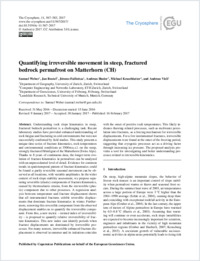Quantifying irreversible movement in steep, fractured bedrock permafrost on Matterhorn (CH)
- Weber, Samuel Department of Geography, University of Zurich, Switzerland
- Beutel, Jan Computer Engineering and Networks Laboratory, ETH Zurich, Switzerland
- Faillettaz, Jérome Department of Geography, University of Zurich, Switzerland
- Hasler, Andreas Department of Geosciences, University of Fribourg, Switzerland
- Krautblatter, Michael Landslide Research, Technical University of Munich, Germany
- Vieli, Andreas Department of Geography, University of Zurich, Switzerland
-
16.02.2017
Published in:
- The Cryosphere. - 2017, vol. 11, no. 1, p. 567–583
English
Understanding rock slope kinematics in steep, fractured bedrock permafrost is a challenging task. Recent laboratory studies have provided enhanced understanding of rock fatigue and fracturing in cold environments but were not successfully confirmed by field studies. This study presents a unique time series of fracture kinematics, rock temperatures and environmental conditions at 3500 m a. s. l. on the steep, strongly fractured Hörnligrat of the Matterhorn (Swiss Alps). Thanks to 8 years of continuous data, the longer-term evolution of fracture kinematics in permafrost can be analyzed with an unprecedented level of detail. Evidence for common trends in spatiotemporal pattern of fracture kinematics could be found: a partly reversible seasonal movement can be observed at all locations, with variable amplitudes. In the wider context of rock slope stability assessment, we propose separating reversible (elastic) components of fracture kinematics, caused by thermoelastic strains, from the irreversible (plastic) component due to other processes. A regression analysis between temperature and fracture displacement shows that all instrumented fractures exhibit reversible displacements that dominate fracture kinematics in winter. Furthermore, removing this reversible component from the observed displacement enables us to quantify the irreversible component. From this, a new metric – termed index of irreversibility – is proposed to quantify relative irreversibility of fracture kinematics. This new index can identify periods when fracture displacements are dominated by irreversible processes. For many sensors, irreversible enhanced fracture displacement is observed in summer and its initiation coincides with the onset of positive rock temperatures. This likely indicates thawing-related processes, such as meltwater percolation into fractures, as a forcing mechanism for irreversible displacements. For a few instrumented fractures, irreversible displacements were found at the onset of the freezing period, suggesting that cryogenic processes act as a driving factor through increasing ice pressure. The proposed analysis provides a tool for investigating and better understanding processes related to irreversible kinematics.
- Faculty
- Faculté des sciences et de médecine
- Department
- Département de Géosciences
- Language
-
- English
- Classification
- Geology
- License
- License undefined
- Identifiers
-
- RERO DOC 288650
- DOI 10.5194/tc-11-567-2017
- Persistent URL
- https://folia.unifr.ch/unifr/documents/305480
Statistics
Document views: 63
File downloads:
- haz_qim.pdf: 142
